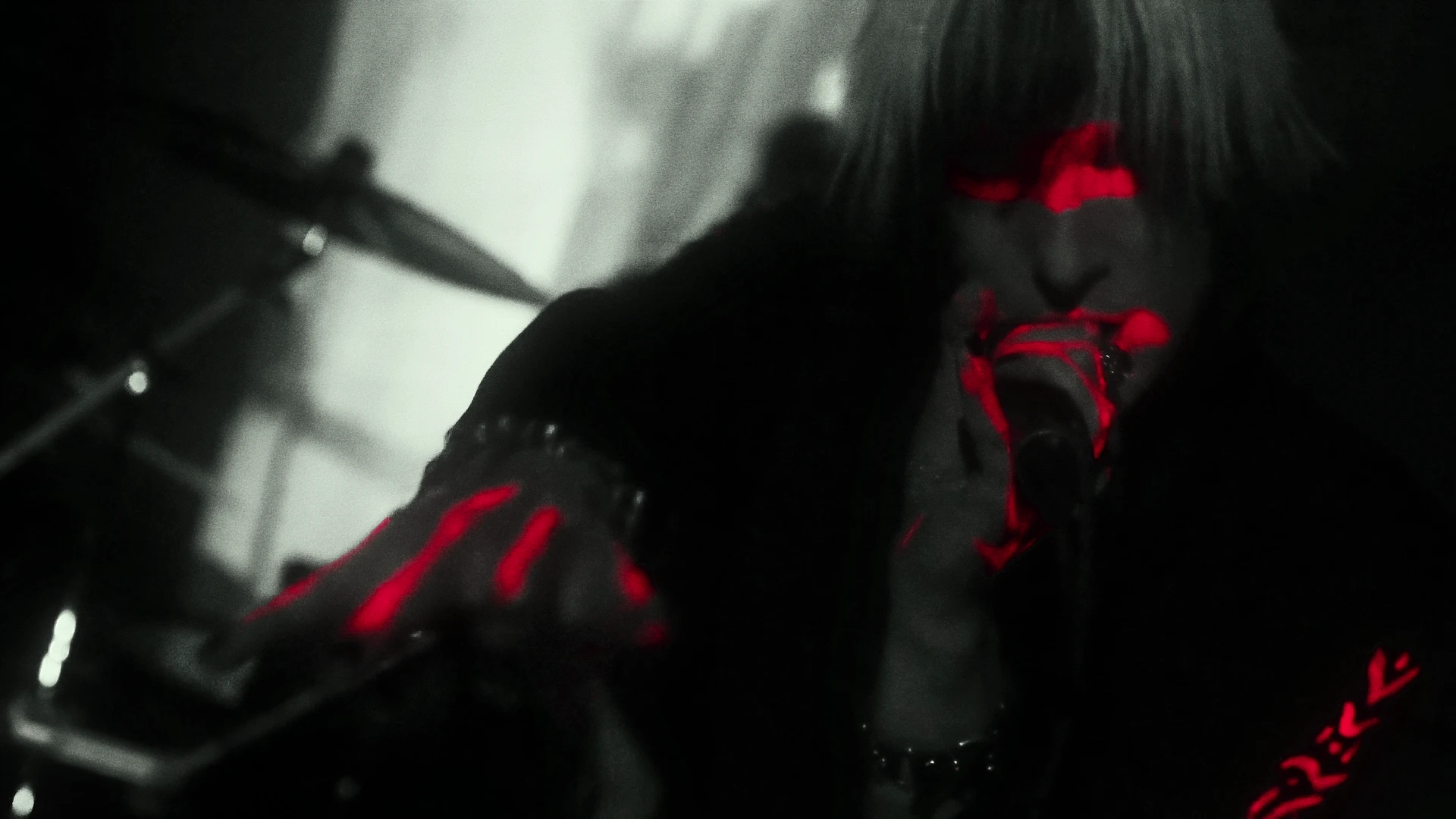
Here’s a new video I produced for the metal band Sinister Cult, who are about to release their debut.
The project had been in the pipeline for a few months, and we finally got around to shooting on June 6th, 2025 - amidst catastrophic chaos. We arrived about 45 minutes late at the location in Mönchengladbach. After clearing out some large office cabinets temporarily stored there, we realized the room was too small for the gigantic drum set that had been brought. It quickly became clear: we either needed another drum set or a different room.
We first tried finding a new location. My sister gave me a few local contacts, but with such short notice - and on a Friday - it was impossible. Most clubs already had events. So we headed back to Düsseldorf. If all else failed, we’d shoot in the band’s rehearsal room.
With permission, I grabbed a few meters of white textile I found in one of the workshops at Waldhausener 62. Little did I know this would become a major asset - and quite an appealing one.
At the HPZ in Düsseldorf, we attempted to use one of their large event rooms, but that didn’t work out either. So we settled for the rehearsal room. It wasn’t much bigger than the original location, but it had a smaller drum kit. As expected, it was cluttered and shared with other bands. After getting the go-ahead, we had to clear the space - basically the entire room.
The walls were covered in a dark grey, felt-like material that absorbed light - great for control, but it would've been a curse without that white textile. After some trial and error, I managed to hang it in a way that didn’t look like grandma’s bedsheets. We also had to patch up the window with more felt material.
So there we were: five people in a closed room on a hot, sunny day. The door had to stay shut because the corridor light couldn’t be turned off. Hours behind schedule, I started experimenting with lighting setups for the middle section of the video.
Using the textile as a large diffuser and lighting it from the back created a very fitting atmosphere. A dim white key light illuminated the front. I also added a UV light from the front, and luckily, the textile was fluorescent - it took on a bluish hue in darker areas and glowed overall, making it look like a large, luminous light source. Suddenly, it no longer felt like a rehearsal room.
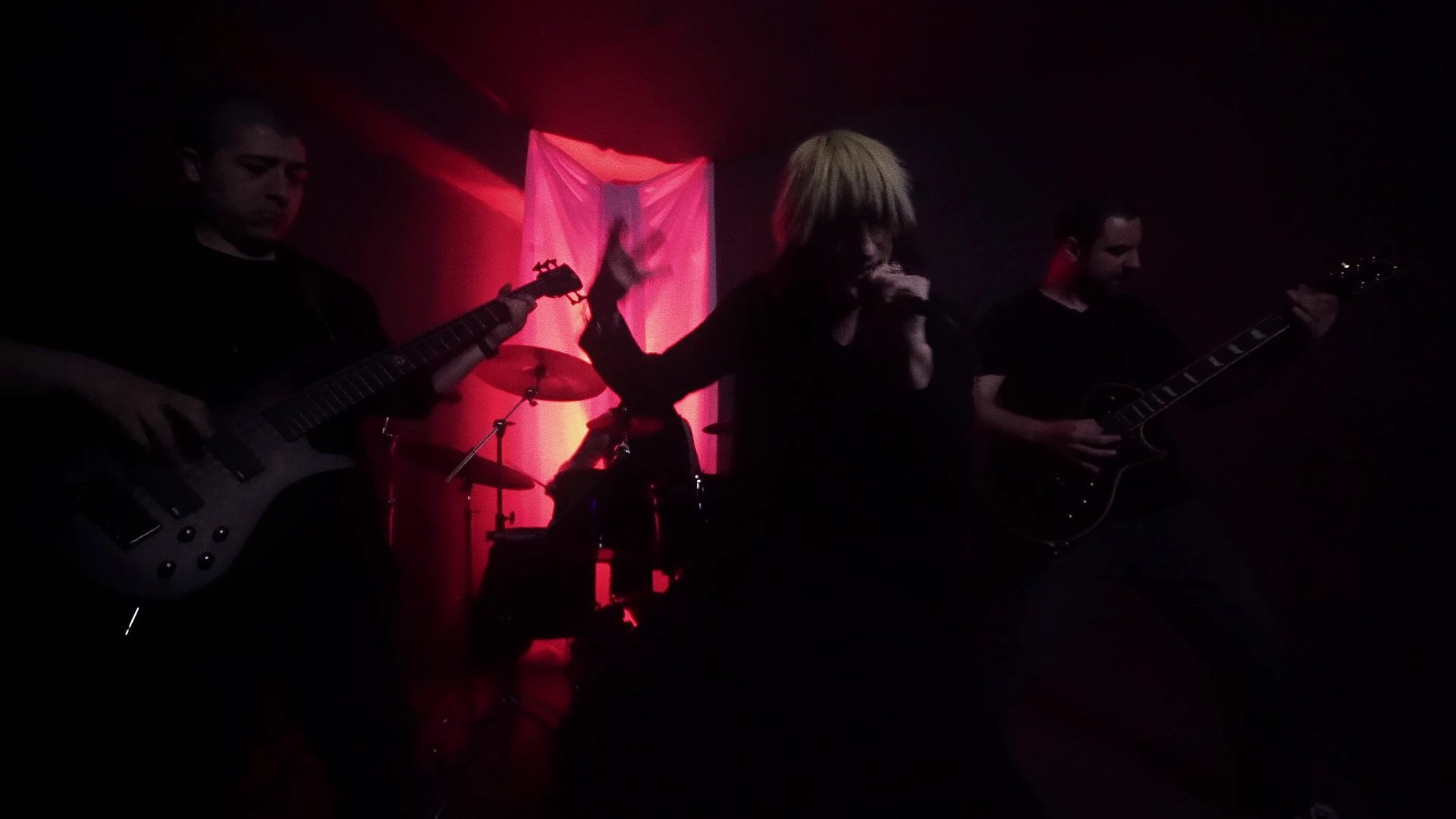
Still, we had lost hours and were already drained from moving heavy gear. But we could finally start filming the middle part. We did 21 takes to a 20% sped-up backing track. In post-production, this would be slowed down to create a more fluid appearance and a contrast to other sections - where we did the opposite.
Then came the more experimental parts. I had the idea to use red UV makeup, blast it with UV light, and turn everything but the fluorescent pigment grey. It worked - kind of - but more on that later.
First, we had to combine musicians and UV pigment. Using my fingers turned out to be the best method. I also drew some extremely satanic scripture in ancient Aramaic on the singer’s sleeves - text that can and should never be translated.
We shot another 15 takes with varying perspectives and lenses. Everyone was tired, but I knew I needed options in the edit - the more, the better. Once again, grandma’s bedsheets played a compositional key role. Bombarded with UV, they glowed like a giant rear projector. Since all UV came from the front, a strange and eerie shadowplay unfolded - at times resembling a skull, with cymbal shadows forming dark eye sockets.
One more break, then another 12 takes for the final part. By then, we were running on autopilot - completely exhausted and digging into the last energy reserves.
We wrapped around 2:00 AM. Cleanup followed. Everything had to go back to where it stood - like nothing ever happened. Fourteen intense hours on set were behind us.
But for me, the real work had just begun. Post production.
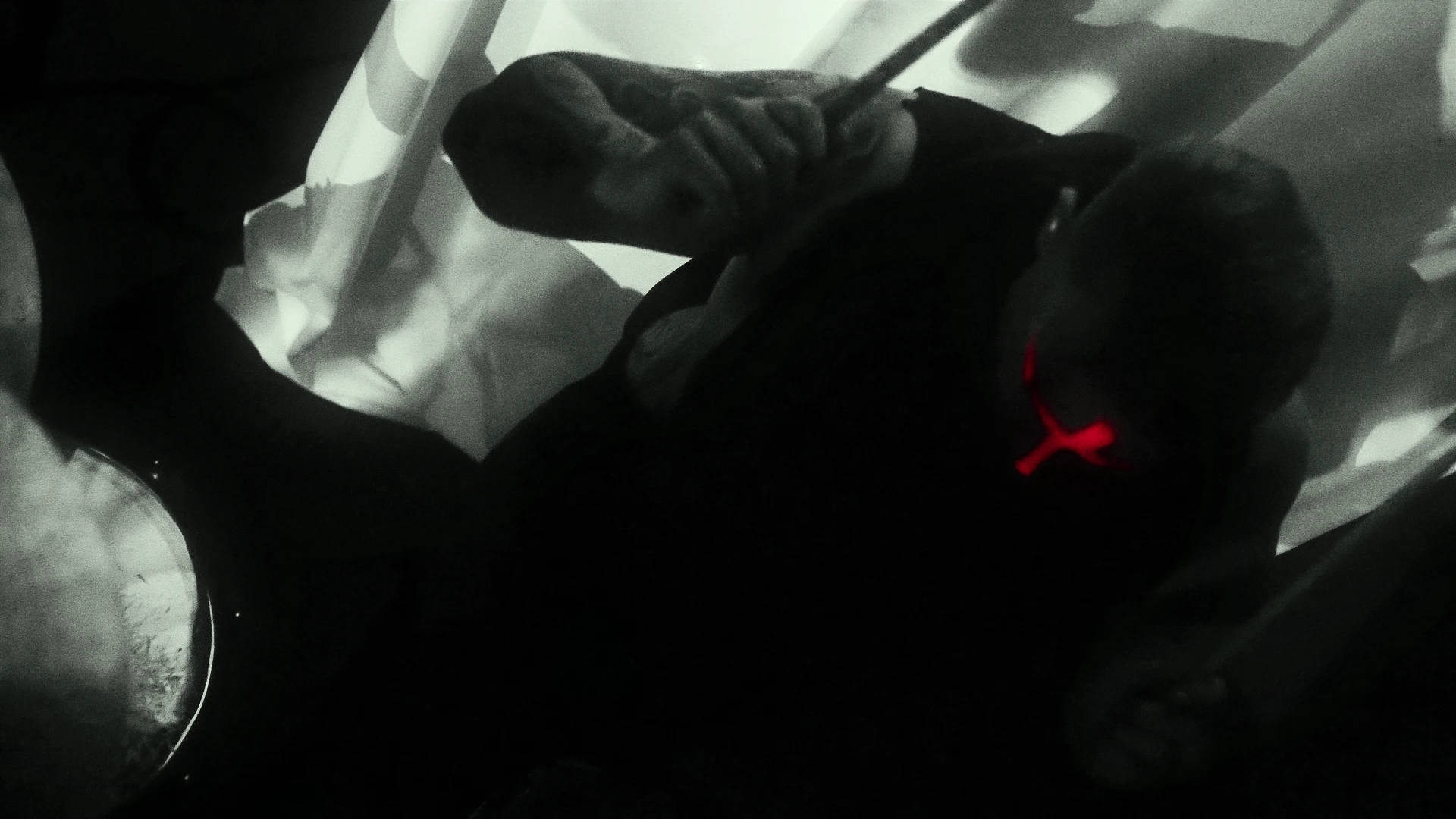
Getting the footage to match the original speed was easy - I had done the math beforehand. But lining up all the clips with the original track took several tedious hours. That kind of work is never fun. Same goes for labeling each take. At that point, I also do a basic dynamic levelling of all the footage, so it matches up.
Once that was done, the project was ready for cutting, which I started the next day. As you can see, it's a fast-paced video, with around 350 cuts over six and a half minutes, averaging one cut every 1.1 seconds. My method is to go through all the footage for a section of the track and simply pick what looks best and fits contextually with the surrounding parts, sometimes creating short arcs with intercut clips.
The better you know your footage, the faster this process becomes. After a few hours, I was almost working on autopilot - occasionally pausing to mull over sections that just wouldn’t flow without extra effort. I usually cut directly on the beat - with a few deliberate exceptions - but this time I relied more on instinct, nudging entry points until they felt right. I think this made the result a bit more dynamic and helped speed up the process.
Still, it took me about three and a half days - only interrupted by sleep and meals.
Midway through, I did a first check to see if the visual concept was holding up - and hell yeah, it did.
In the final section, I ran out of suitable footage for a few cuts, so I re-used some shots and pulled unused clips from the first part, since it shared the same musical structure. I had to re-sync them (sigh), but they fit.
With the cut complete, I moved on to the part I enjoy the most - and can be the most misleading if you spend too long and lose perspective: color grading. This is where I explore what the material can offer and how far I can push it. Even though I had a clear vision for the video, I still wanted to try some alternatives. You never know. (Note to self: don’t send experiments to the band.)
In the end, I stuck with the original vision - now fully confident it was the right choice. The middle section has almost no color grading. For the first and third parts, I greyscaled everything but the makeup and gave the image a greenish hue to create stronger contrast. I used a greyscaling process that best mimicked the UV light effect, giving it that unnatural blacklight look.
Another cool effect: the black eyes - also thanks to UV. But it wasn’t enough to just isolate the makeup and let that show. To make it really pop, I needed to key the color and use the resulting mask for a color overlay.
That’s where the trouble began.
Because I had to shoot with high ISO - using UV as the main light source - there was a lot of noise. That noise contained parts of the key color, which contaminated the mask. On top of that, reflections and light refractions in shiny metal parts - drums, guitar, bass, and the singer’s jewelry - created additional interference.
Despite doing my best with key settings, I ultimately had to manually clean the mask frame by frame. That meant another two days of painfully tedious work, with 230 individual corrections and a second check to fix what I'd missed the first time.
But I wasn't done yet. The next step was polishing the video. Since the footage was quite noisy, I used a filter, which gave its best result by setting it to absolute maximum and blending it in with the original. I don't like digital sensor noise, but film noise has a pleasant aesthetic, so I merged in a 35mm film noise scan, you can prominently see in the finished video. This helped create mood and also nicely concealed the remaining digital noise.
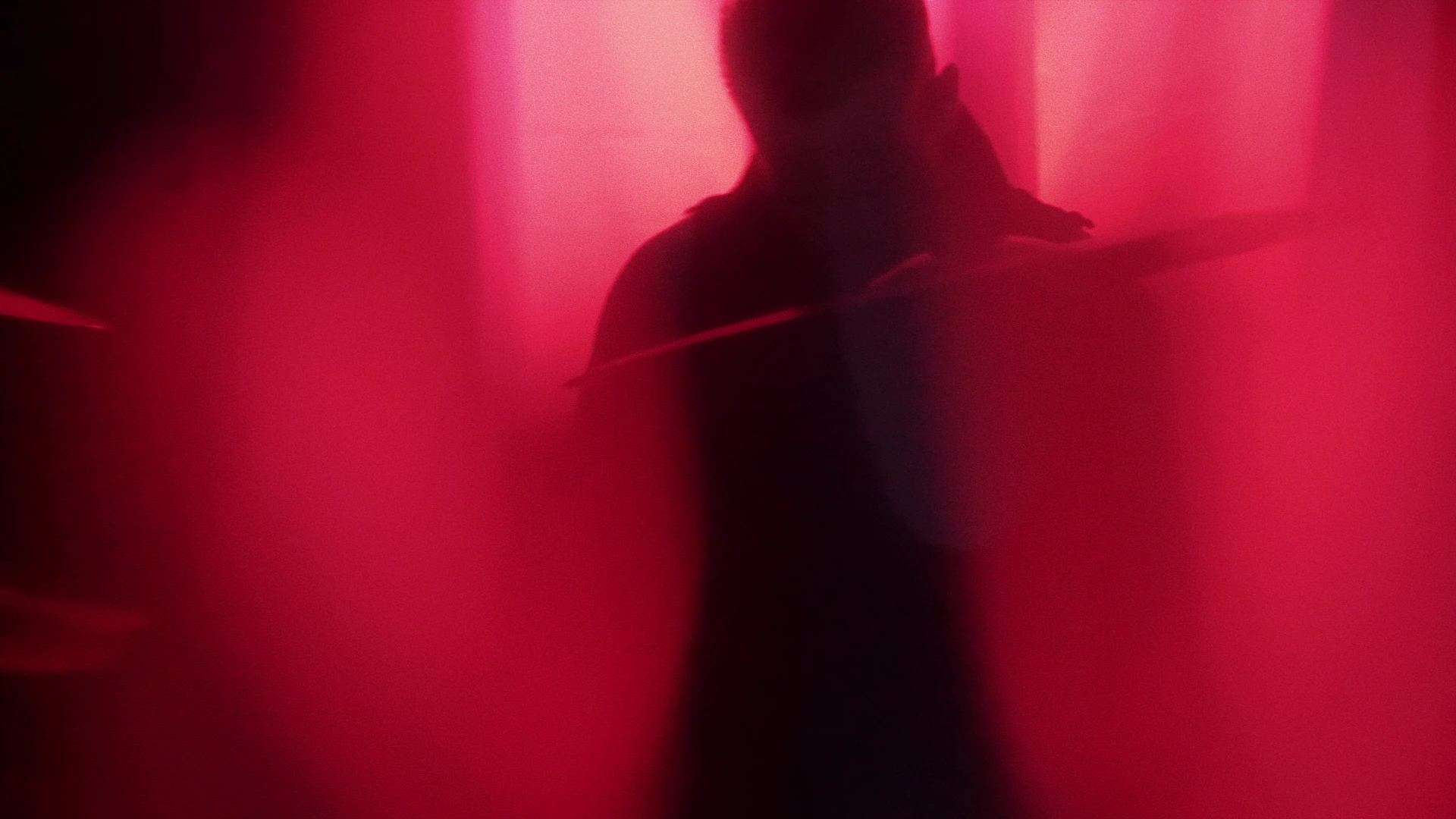
I also added a diffusion effect - despite having already shot with a black mist filter on the lens - which greatly improved the fluorescent effect of the white textile, making it look even more like a big light source. The UV makeup received a minute amount of glow and I used a cautious amount of sharpening on edges only (making another mask for it). I tried other effects, but decided for the bare minimum of what the video requires.
A few hours also went into making an intro that the band didn't seem to like, so I replaced it with a minimal version, putting effort into finding the right font, adjusting the kerning and getting the timing just right.
Last step: rendering. Well, not really. Watching and rewatching the result I found little things I didn't notice before. So I fixed them, rerendered, fixed again... You get the drift.
And here we are. I hope you enjoy the video and appreciate the whiff of sweat that went into making it. As with every project, I learned a lot and, despite the emotional rollercoaster, genuinely valued the experience. Chaos and improvisation can be a great catalyst for creativity.
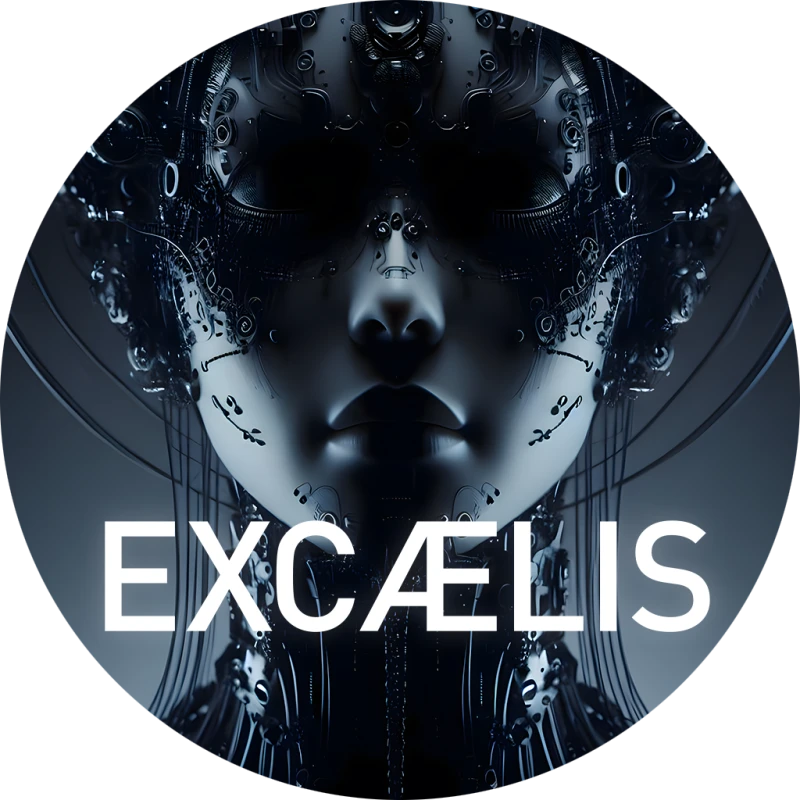

0 comment(s)